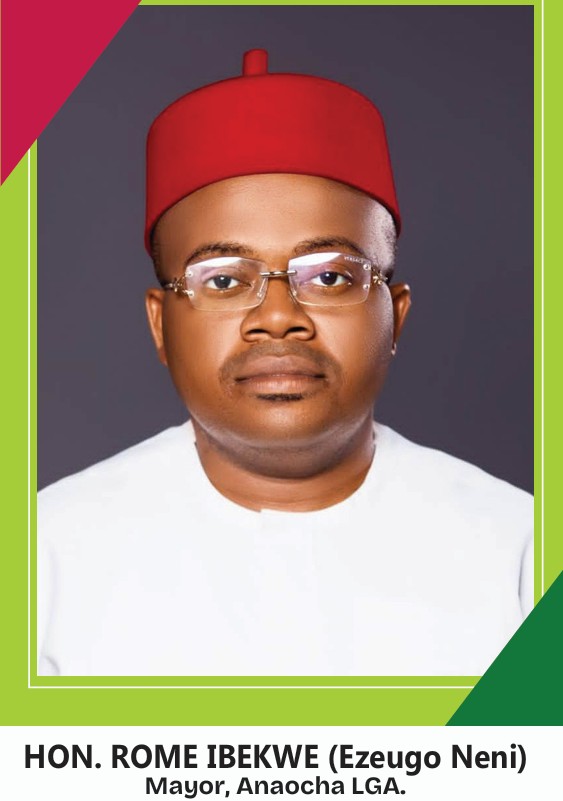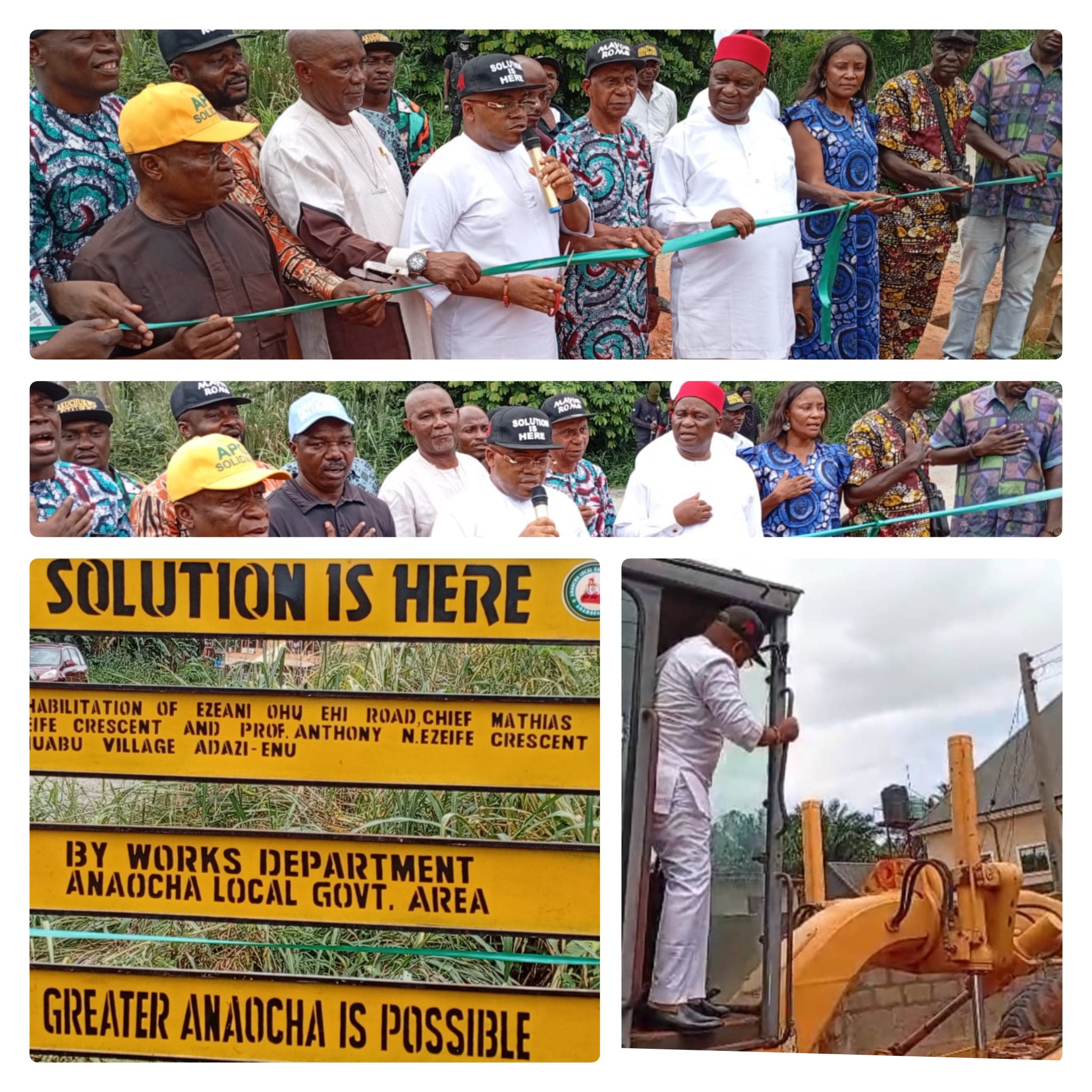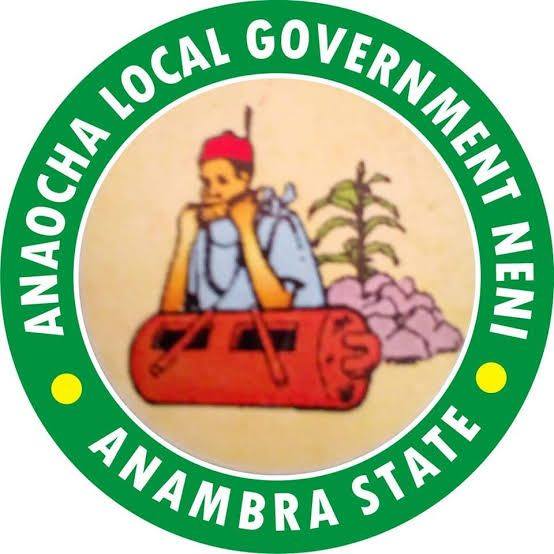About Us
About us

A BRIEF HISTORY OF ANAOCHA LOCAL GOVERNMENT AREA
Anaocha Local Government Area is one of the twenty one Local Government Areas in Anambra State of Nigeria. Geographically, it is bounded in the North by Awka South Local Government Area, in the East by Aguata Local Government Area and in the West by Njikoka Local Government Area. It has a landmass of 171.62 square km with a population of 199,093 (according to the 1991 census) and falls within the tropical climate and vegetation. It is potentially habitable.
Anaocha Local Government Area was a part of Njikoka Administrative Area whose existence dated as far back as 1957 known then as Niger County Council and later changed to Njikoka County Council. However, during the Local Government reforms of 1976, it became known and called Njikoka Local Government Council. It is germane to point out that with the Local Government Reforms of 1976, many groups of people that share the same homogenous socio-cultural affinities desired and indeed demanded to be identified and given a Local Government of their own. Among these group were the people of Anaocha Local Government Area which was created in 1983 by Chief Jim Nwobodo, the then Executive Governor of Anambra State. It comprises of Agulu, Aguluzigbo, Adazi-Ani, Adazi Enu-, Adazi Nnukwu, Akwaeze, Ichida, Neni, Obeledu and Nri.
In 1984, the creation of this Local Government Area was cancelled by the then Buhari-Idiagbon Administration. On May 3rd 1989, Anaocha Local Government Area was created from Njikoka L.G.A with her Administrative Headquarters at Neni. It was under the then Military Governor of Anambra State, Col. Robert Nnaemeka Akonobi. At present, Anaocha Local Government is under Anambra Central Senatorial Zone and Anaocha, Njikoka and Dunukofia Federal Constituency. .
THE CLANS THAT MAKE UP ANAOCHA LGA
Anaocha Local Government Area as presently constituted consists of three clans with their communities, namely:
AGULU CLAN: Agulu and Aguluzigbo
UMUNRI CLAN: Nri Community
AGUINYI CLAN:
EZENNEBO COMMUNITIES: Neni and Akwaeze
OKOTU COMMUNITIES: Adazi-Enu, Adazi-Ani, Adazi-Nnukwu, Ichida and Obeledu
Igbo people generally have four main markets, namely: Eke, Oye, Afor and Nkwo.
Anaocha LGA has these four markets and their days. Though there are other markets, but each of the ten communities has one of these markets as its main market, the day of such markets attracts more people and the community is known for that.
The Anaocha ten communities and their respective main markets.
Adazi-Ani -Eke
Adazi Enu -Nkwo
Adazi-Nnukwu -Eke Agu
Agulu -Nkwo and Eke
Aguluzigbo -Oye
Akwaeze -Afor
Ichida -Oye
Neni -Oye
Nri -Eke
Obeledu formerly Nkwo but now -Oye

BRIEF HISTORY OF THE TEN (10) COMMUNITIES IN ANAOCHA LOCAL GOVERNMENT AREA OF ANAMBRA STATE IN ALPHABETICAL ORDER
ADAZI ANI
Adazi-Ani is made up of ten villages- Eziora Village, Ikenga village, Umuosu Village, Umuoma Village, Amaeku Village, Dimnam Village, Ezietiti village, Urunkwo Village, Otutu Village and Uruezeama Village. It is an Igbo town which is south-western end of Anaocha LGA of Anambra State of Nigeria. It is about six kilometers from Nnewi and about 18 kilometers from Awka. Adazi-Ani is bounded on the east by Neni, the Headquarters of Anaocha LGA, on the west by Alor and Nnokwa, on the south by Adazi-Enu and on the North by Oraukwu.
The Town covers a land area of about 16square kilometers. At the south western end of the town is a table land popularly known as Ama-Uku and from here, the land descends towards Nnokwa, Alor-Oraukwu and part of Adazi-Enu. Adazi-Ani belongs to the equatorial rain forest vegetation zone. This was evidence by the thick forests and the luxuriant growth of mahogany tress (locally known as Uku) that were regarded as the totemic tree in the town. It was only after the Biafran war that the trees became de-totemized, cut down and sown into: timbers.
Adazi-Ani has a typical West African tropical climate. ORIGIN AND SETTLEMENT Adazi-Ani is counted as one of the nine sons of great apical ancestor named Okotu. There is absence of written records regarding the Origin of Adazi-Ani but oral tradition abound not only about the town but also about other sister towns that traced its descendants from Okotu. Ageless Kingship and cultural relations existing between these towns were celebrated in common customs, traditions and usages, in myths and songs, in adages and maxims. These towns are Adazi-Enu, Adazi-Nnukwu, Ichida, Obeledu, Amaichi, Ogbodi, Ikenga and Osumenyi. Due to land extension and administrative convenience, some of these towns were carved into other local governments. At present, it has three major Christian churches: The Catholic, the Anglican and the Pentecostal churches.
ADAZI-ENU (OBI OKOTU)
Adazi-Enu is richly blessed with a lot of cultural heritage and festivals which include Iwa Ogodo (for the young adult male) Ime-ezi (for the young matured girls), Iro Muo (special sacrifice to their deity), Ichi Ozo (taking of title by the rich and influential people in the Community). They have masquerades like Ekwulo, Okwomma, the Oji-Onu and Izaga. She embraced the Christian religion in 1908 with CMS as the first Christian religion to come into the town.
ADAZI-NNUKWU
Origin:
• Umudiana people were the original inhabitants of Adazi-Nnukwu.
• Amaide also inhabited its place before the arrival of immigrant groups of Adazi-Nnukwu
• The Immigrant groups were Amolu, Nnukwu and Amata.
A powerful hunter called OKOTU who was said to have hailed from Adda, while others regarded him as the son of Ona who was also the father of Umuona and Isuofia, migrated and settled at Okobu in Adazi-Enu before 1576AD. Okotu had two wives; the first begot Adazi-Enu, Adazi-Ani and Adazi-Nnukwu and the second begot Ichida, Obeledu, Amichi and Osumenyi. The youngest son Ovunukwu (Nnukwu) left his place of birth (Adazi-Enu) to settle at Ani-lsioha, area of about 5kms from Adazi-Enu. In summary, the origin of Adazi-Nnukwu begins with a synthesis of various units dwelling within the land mass called Adazi-Nnukwu. It commenced with two villages Amolu and Nnukwu. The other three; Umudiana, Amaide, and Amata of different genetic or genealogical origin fused with these two components to generate a town now identified as Adazi-Nnukwu. The original inhabitants of what is today called Amata migrated from Abba (now in Njikoka LGA) as hunters who were fully accepted and protected by "the Umudiana aboriginals. At present, after infusions of villages, Adazi-Nnukwu has three clans of nineteen villages. The town has its major church as Saint Andrews Catholic Church which was established in 1912.
Component Clans And Villages
• AMOLU CLAN: Isioha, Okpalaekili, Umugama, Osiemekua
• NNUKWU CLAN: Okpalagbo, Dim Nwaneme, Nkpolo, Orofolo, Umudiana, Eziafor, Ezinwoye, Etiti
• AMATA: Umunnebo, Eyisi Obuno, Umudunu Oganya, Uruagu, Aboma, Amorji
AGULU AND ITS CULTURAL HERITAGE
The Origin of Agulu is uncertain but it was traditionally believed to be founded by a man named Aguluefo, whose ancestors ran back to Akutaekwe. He begot Ezeonwuekwe who later begot Ezechukwu. Ezechukwu was the father of Ibe who married two wives. The first wife wanted to name her son Aguluefo but the second wife put to birth first and named her son Aguluefo. When the first wife put to birth, she still named her son Aguluefo (shortly called Agulu) without any conflicts. The elder son lived at Obu Mgbako Agulu or Agulu Enu while the younger son lived at Agulu Ndida. The eldest begot nine children namely: Nwanchi, Okpu-Agulu, Amaezike, Nneoha, Odidama, Amorji, Isiamigbo, Ukunu, and Uhueme. They are called "Agulu Ebeteghete." The younger son had eleven children namely: Obeagu, Obe, Nkitaku, Okpuifite, Umubiala, Amatutu, Umuowelle, Umunonwu, Upiuifite and Nneogidi. They are called "Agulu Ebemonu". These children form the villages in Agulu. It is also believed that Nneogidi is the daughter of Ogidi in Idemili South LGA who was married off to Agulu. In each village in Agulu, they have their Umunna (Kindred name) and Umuada.
Agulu has different titles usually taken like; Amanwulu and Chi, Uke, Ozara, Ifejioku, Nze, Ozo (which is one of the most respected). It has Ozoebetehete and Ozoebemonu. The Ozoebetehete comprises of those who wear red cap and rope on the leg. They include: Ozo-Okpala, Ozo-Ezeani, Ozo-Ebenesi, Ozo-Ebenato, Ozo Eyisi. It is the duty of an Ozo titled man to administer justice to the people.
Agulu has many festivals which include: Ife Ududonka, Ife Haba, Agomchi, Affiachi, Ikpoji, New Yam Festival (Oriri Ji Ohuu), Isi Ekwensu Amanwuru, Onwaibo. Agulu also has some tourist centres like: Agulu lake at Umuowelle, Agulu Erosion Site between Amoji and Isiamaigbo, Idemili Omeleagbha or Ojebere Ka-oziri, Oyetoro or Oyegbara Agula Ara.
AGULUZIGBO
Through the process of Polygamy, Agulefo fathered the founding fathers of Aguluzigbo, Aguluenu and Aguluana. This became their underlying connection/ relationship. She has an estimated area of about 8 Sq. Miles which tapers towards the southern portion facing Igbo-ukwu and with a population of about 100,000 people. Aguluzigbo comprises of six large villages, all of which claim decent from one ancestor. These villages in turn, are composed of kindreds (Umunna) and each kindred is a conglomeration of lineages and families that similarly believe of having descended from a common father. The six villages of Aguluzigbo are: Ihuowelle, Etulueze, Ihulu, Uffa, Ifite and Nduana.
They have many cultural festivals such as Gbudugbu, Mbedibia, Onumankwu and Akpan as well as the masquerade society. They also have the New Yam Festival celebrated yearly, on the last Friday and Saturday in the month of August and the Igwe usually celebrate his Ofala festival in the month of December. Agulizigbo's village markets were established in some strategic points in the community. There was the Eke and Oye in Etulueze, Afo and Nkwo Udo in Ifite. However, it is only the Oye Market that still survives as the major market in the town. Her town Union is named Aguluzigbo Development Union (ADU) and was founded by Late Chief Ben Ogbonna MBE who was from Nduana village.
AKWAEZE
The younger son, Eneninaubosi on coming of age, was directed by Ezennebo to leave the Obi for Akwa, the elder son. He then left and settled near the forest called Ajofia Obiajulu from where he checked the constant attacks of enemies from that sector of the town. The name Neni is believed to have been coined from the name Eneninaubosi. Eneninaubosi recognized the cordial relationship that existed between him and his brother and of course, his father's Obi. As is traditional, he showed appreciation for this cordial relationship through the traditional Ibu-lru (Homage) which is a mark of respect for an elder brother and Obi. Apart from Ibu-lru, there is a common Idol worshipped by the two towns called Ibenne.The Chief priest of the idol always comes from Akwaeze. In the past, both towns jointly carried out the funeral ceremonies of their deceased relation. Also, Akwaeze and Neni are jointly referred to as Ebemisi which means sixteen villages. This was derived from the unification of the six villages of Akwaeze and the ten villages of Neni.
Akwa was said to have four aboriginal villages namely according to seniority are: Umuezeani Village, Umuideke Village, Uruonyili Village, Umutu Village. After these four aboriginal villages, the fifth and sixth village (Uruolu and Mgbuwa) of Akwaeze were said to be heterogeneous, made up of migrants from different areas as there was no trace of the descendants of Akwa and Eneninaubosi found in them.
As the town grew through procreation, Akwa felt there was no need to change the name so it was called arAkwaeze but later in 1957, the name was changed to Akwaeze. The "Eze" was meant to remind the people of the legendary "Ezennebo." Akwaeze people have many cultural heritages which includes: Ozo title taking, Idi title taking, New Yam Festival (Iwaji), Age Grade System, Ebe ceremony, Masquerading, among others. As a traditional community, Akwaeze had established its own system of calendar which was made up of thirteen Lunar Months for regulating the religious, social and economic life of the people. Each lunar month consisted of seven native weeks while each week was made up of four days beginning with Eke, Oye, Afor and Nkwo. The Lunar Months are: Onwa Donogo Ndiinyom (First lunar Month; marked the beginning of Ebe Ceremony in the town), Onwa Nni oye (Ebe Ceremony continued), Onwa Mbugu Donogo, Onwa Donogo Ndikom (observed by men alone), Onwa Isi Ekwensu (observed in anticipation for the New Yam Festival), Onwa Akuku, Onwa Afia Chi, Onwa Muo Okuko, Onwa Hi, Onwa Monu, Onwa Mgbuji Nku, Onwa Mato.
Other cultural ceremonies in Akwaeze include, Ikeleoji, ego, Igba uke, ita Akwu, Igba Mbe, etc.
ICHIDA AND HER CULTURAL HERITAGE
1: Ihe village,2: Dunuebo village,3: Elimehi village,4: Uranudo village,5: Mgbuwa village,6: Umuebo village.7: Umuakata village.8: Umuezesue village,9: Nnulukwu village,10: Ubulu village,11: Uhuanaoma village,12: Ezebazu village,13: Udoama village,14: Amuleri village,15: Uhuana village,16: Mgbudu village,17: Umukam village,18: Umuezeonyedi village,19: Ajani village and,20: Umudunuagu villages
are the 20 villages that make up the Ichida town in Anaocha LGA.
NENI COMMUNITY
Neni people are bound together by economic, sociological, cultural and customary factors. Thus cultural festivals abound in the town. These include Umudioka Arts and Cultural Festival, Ogwe Cultural Festival, Villages Cultural Day Celebration, Manwu (Masquerade) Festival, Iwaji Festival, etc.
NRI
Nri Kingdom was founded around 994AD. The people of Nri Kingdom are descendants of Eri. The genealogical tree of Nri is as foolows: Abraham begot Isaac, Isaac begot Jacob, Jacob begot Gad, Gad begot Eri and Eri begot Nri and three other brothers and a daughter namely: Onogu (who begot Igbariam), Ogbodudu (who begot Amanuke), Agulu (who begot Aguleri) and the only daughter Iguedo (who begot Ogbunike, Nando, Awkuzu, Umueri and Nteje).
Nri left their father's ancestral homeland at Eri-Aka, about 7km in the interior of Aguleri, very close to the confluence of Ezu and Omambala rivers. He first settled at Amanuke with his brother Ogbodudu. After some years, he left Amanuke and settled at Ugbene in the present Awka North LGA. Because he was a hunter and native doctor, he left Ugbene and arrived at the present Osili Village in Enugu-Ukwu. There, he begot Enugwu-Ukwu, Nawfia, Enugwu-Agidi and a daughter, Amawbia. All these communities are in the present Njikoka LGA and Awka South LGA. Nri (Ifikuanim) finally settled at the present Nri town and there, he had so many children. Today, there is 189 communities that Nri formed, both in Anambra, Abia, Imo, Delta, Cross-River, Rivers and Enugu State.
Nri is made up of three sections namely: Agukwu (comprises of three villages: Agbadana, Uruoji and Obeagu), Akamkpisi (comprises of two villages: Ekwenayika and Uruofolo) and Diodo. Nri kingdom is estimated to have approximately 200,000 inhabitants.
Nri has many rich cultural activities which include; Iguaro, Onwa Agwu Festival, llomuo (Onwasato) or New Yam Festival. Nri Progress Union was registered in 1944 and its first President-General was Mr. N. N. Eneanya. The Nri people is known for their religious attributes; they have Catholic, Anglican, Pentecostal, Assemblies Church, Sabbath Mission and Traditional Religious Worshippers (because Nri is known for their belief in SUN CULT, which their progenitor introduced into the Igbo race around 994AD).
OBELEDU AND HER CULTURE
The leadership of Obeledu town comprises of the Traditional Institution and the Town Union Government. Prior to the evolution of the present leadership structure, Obeledu like many communities in Igbo land was administered by the Council of Elders. Somehow, Obeledu still retains this Council of Elders called Ikele, for some other roles in the community. The official designation of the Igwe of Obeledu is the Ezeoranyelu of ObeledU. The traditional institution is headed by the Traditional Ruler, referred to as the Igwe of Obeledu, the office is for and non- hereditary but rotates among the eight component villages of the town. He is usually assisted by the Onowu who shall hold forth as the Regent in an interregnum that follows the death of an Igwe and the Installation of a new one. In addition to the Onowu, there are thirty other respectable and credible men drawn from the eight villages of the town who are referred to as the Ichies (who advises the Traditional Ruler and sits with him to make decisions in the Royal Council; Igwe-ln-Council). Every member holds an Ozo title. Obeledu has a central market place where commerce is conducted on Oye Market Days for her people and visiting traders.
